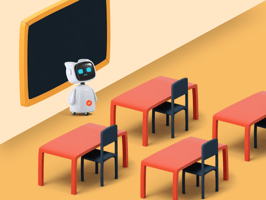AI is an invaluable tool for teachers. However, knowing how to communicate with AI effectively is...
Redmenta AI-cademy: The Future of Essay
AI is revolutionizing the way we approach essay writing. Is it just another way for students to cheat, or can it actually improve their writing skills?
2022 was a big turning point for AI text generators - since Chat GPT became widely available to the public, it has suddenly become part of our lives. But this also causes a big concern in the academic field regarding ownership, plagiarism, or copyright issues, especially for essay tasks.

LLM, the system behind the tools
At the heart of AI text generators are language models. According to Technopedia’s definition, Large Language Model (or simply LLM) is a type of machine learning model that can perform a variety of natural language processing (NLP) tasks, including generating and classifying text, answering questions in a conversational manner and translating text from one language to another.
The most popular LLM is GPT-3 (Generative Pretrained Transformer 3) developed by OpenAI. Still, major tech-giants also have their models: BERT (Bidirectional Encoder Representations from Transformers) or T5 (Text-to-Text Transfer Transformer) developed by Google, RoBERTa (Robustly Optimized BERT Approach) by Facebook AI. More recently, Microsoft and Nvidia open-sourced a model dubbed Megatron-Turing Natural Language Generation (MT-NLG), which is among the largest models for reading comprehension and natural language inference.
Automatic writing tools used for essays
While AI writing tools are a cause for concern among educators, they offer a range of benefits for students: to generate new ideas, expand their vocabulary, and improve the overall quality of their work. AI-powered tools such as Grammarly can detect spelling and grammar mistakes, recommend alternative word choices, and offer insights on writing style and tone.
In a Guardian article, a journalism professor gave an assignment to an AI tool and was impressed. The essay was entirely on point, and he would have given the AI a good grade. “Academia has some serious issues to confront.” - he added.
Sure, students should not be allowed to submit AI-generated content as their own, but chatbots could help them streamline the research process at the beginning of their work. Explain to your students that chatbots do not verify the information and could be errors in the outputs, therefore, they require critical thinking. When it comes to research, Bing is more reliable than ChatGPT, as it lists its sources.
Since citing the sources properly can be a struggle for students even in higher education, AI could provide a solution for that too.
In his recently published article, Martin Robson tried various AI tools that offer essay writing.
One of his main findings was the importance of the citation generator: while it is considered a weakness in Chat GPT, it works slightly better on Writesonic/Chatsonic (a tool that targets marketers, bloggers to create SEO-optimized, plagiarism-free content) and much better on Jenni.ai, which offers a choice of MLA or APA 7th and users can choose websites or journals as sources.
Using AI writing tools also raises questions about equality, as some students may have access to more advanced tools than others.
How to detect it?
In higher education, most schools use software for plagiarism detection that can cross-check essays. But AI-powered assignments can easily pass these checks.
According to Jonathan Bailey on Plagiarism Today, the solution is to use AI to detect AI. He says that these tools are expected to evolve alongside AI writing. Several examples are already available that examine patterns in writing, even if a human edits or rewrites it. Like the RoBERTa Base OpenAI Detector, which uses OpenAI’s own models to detect AI writing.
His other recommendation is Authorship Detection, which is the same concept as AI detection, but from the opposite direction. Tools like Turnitin and Unicheck are designed whether the paper was written by a different author (whether it is human or AI) by analyzing and comparing a large amount of text known to be written by the student. These can also be done manually by looking for inconsistencies in the text. Teachers should look for patterns and compare it to previous essays written by the same student.
AI-proof essays
Lastly, creating AI-resistant assignments, tasks that an AI would struggle to complete, can also be an effective method, Bailey says. AIs can only write about information on the public internet, so including content specific to the classroom or unique to the student can help prevent AI-generated writing.
Tips for an AI-proof essay:
-
Creative prompts: Essay questions that require students to draw on their own experiences or creativity. Ask students to write a personal essay or create a piece of art that demonstrates their understanding of a concept, instead of a clear question a search engine can find.
-
Short answer questions: Questions that require a short answer or explanation can be more difficult for AI to generate.
-
Open-ended questions: Open-ended questions require students to think critically and engage with the material, which can be more difficult for AI to complete. This could be questions that require students to analyze a case study or explain a concept in their own words.
+1. Implementing in-person oral interviews could be a good solution, though there can lead to pedagogical and accessibility obstacles.
In conclusion, while AI offers many benefits for students, its potential misuse also raises concerns about equality and academic integrity. As educators and students navigate this new landscape, it's essential to consider AI writing tools' ethical implications and explore ways to use them responsibly.
Want to incorporate ethical AI into your teaching?



